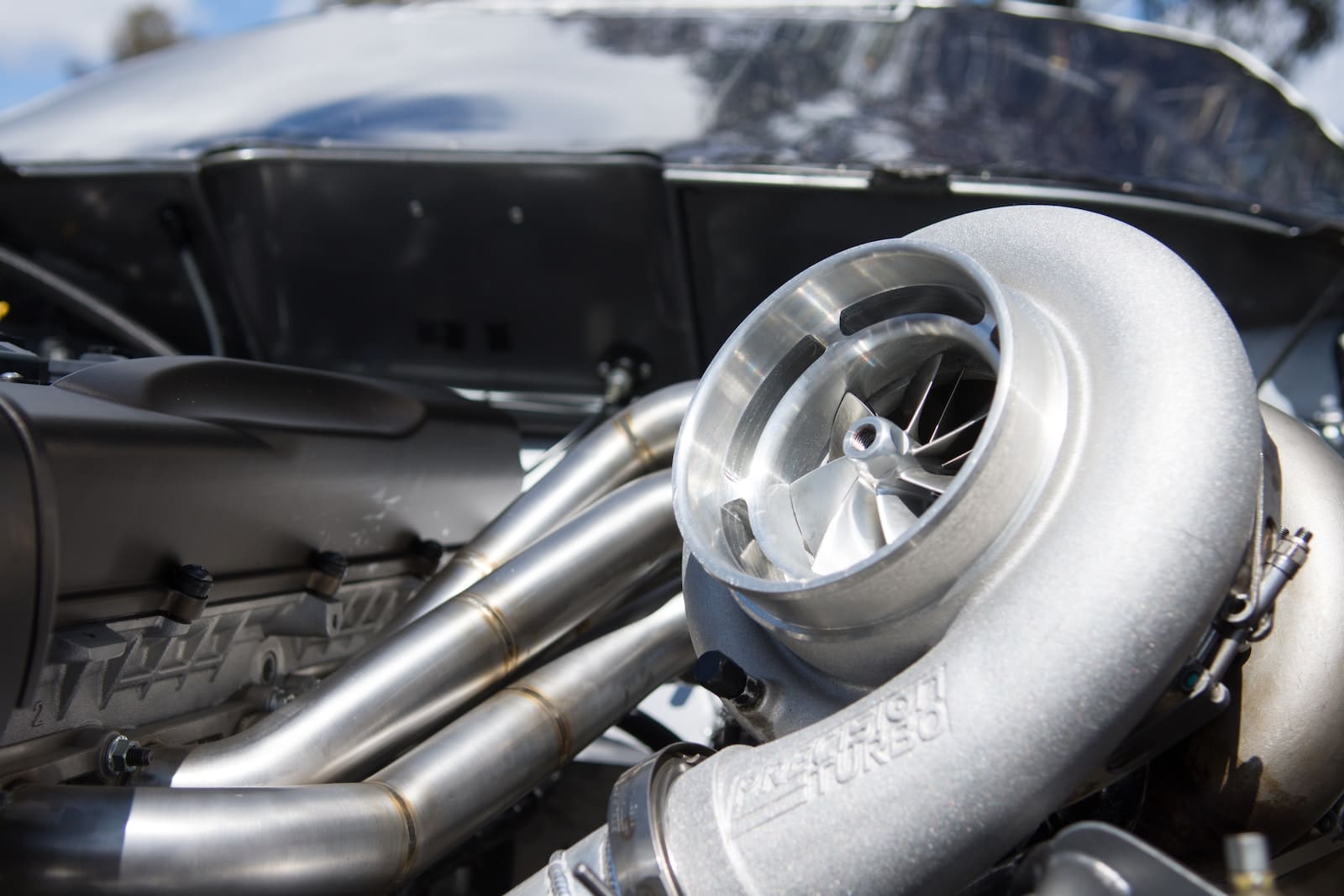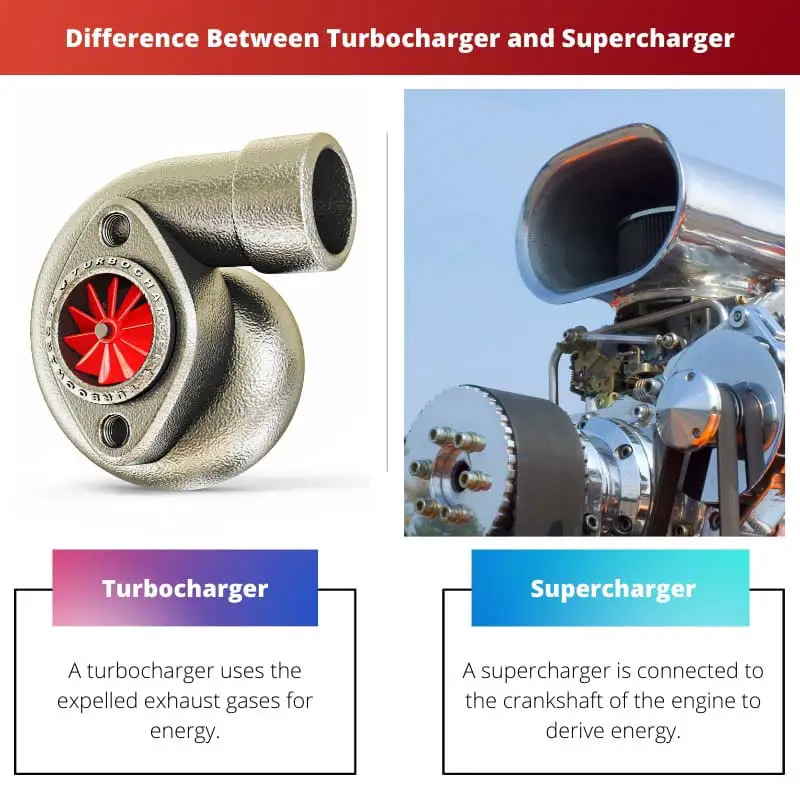A car, sports car, truck, train, aircraft, or even a construction equipment engine all have one thing in common for sure- they run on engines.
To enhance their power output performance, automotive manufacturers have all geared up to jump into the war of horsepower. To increase fuel economy and boost the engine’s power output, the unparalleled turbocharger and supercharger were invented.
Key Takeaways
- Exhaust gases drive turbochargers, while superchargers are driven by a belt connected to the engine.
- Turbochargers offer better fuel efficiency, while superchargers offer better throttle response.
- Turbochargers are more complex and expensive than superchargers.
Turbocharger vs Supercharger
Turbochargers are powered by the engine’s exhaust gases and are more complex and require more maintenance than superchargers. Superchargers are powered by a belt that connects to the engine’s crankshaft, work by compressing air and forcing it into the engine, and are powered directly by the engine.

A turbocharger is like a turbine that uses exhaust gases to compress the atmospheric air and sends the air into the combustion chamber, thereby boosting the engine’s performance.
Instead of wasting the exhaust gases being expelled from the combustion chamber, a turbocharger harnesses it by using three fans, two of which are situated on the same shaft and the other in the car’s intake that draws the air into the engine.
A supercharger is commonly used in sports cars. It runs mechanically and boosts the density and air pressure that enters the engine. The more the air enters the engine, the more power is generated.
A supercharger has a belt, chain, or shaft that is connected to the engine’s crankshaft, and its primary function is to boost the power output.
Comparison Table
| Parameters of Comparison | Turbocharger | Supercharger |
|---|---|---|
| Source of Energy | A turbocharger uses the expelled exhaust gases for energy | A supercharger is connected to the crankshaft of the engine to derive energy |
| Spinning Speed | It spins up to a speed of 150000 rpm | It spins up to a speed of 50000 rpm |
| Sound Emission | The sound emission is lower than a supercharger | The sound emission is more than a turbocharger |
| Compressed Air Temperature | The temperature of the compressed air is quite high in a turbocharger | The compressed air is at a lower temperature |
| Rotation of the Compressor | The turbine rotates the compressor | In a supercharger, a belt is connected to the engine crankshaft, and this engine crankshaft rotates the compressor. |
What is Turbocharger?
A turbocharger is a forced induction system that harnesses the power of the exhaust gases expelled by the combustion chamber and boosts the engine’s performance.
The history of turbochargers can be traced back to the 1800s when Gottlieb Daimler was experimenting with forced induction. It was in 1905 when a Swiss engineer, Alfred Buchi, patented his car power booster.
Thereafter, similar prototypes were used in aircraft, diesel ships, and vehicles. Tests demonstrated that these engine add-ons could boost power output, reduce emissions, and improve fuel economy.
A turbocharger consists of two fans situated on the same shaft. One fan is situated on the path of the expelled exhaust gases from the combustion chamber.
The exhaust gases coming out starts the impeller, which in turn makes the other fan situated on the shaft revolve. There is also a third fan that is situated in the car’s air intake, and it is this fan’s propulsion that draws the air into the engine.
The air that is drawn into the engine is compressed and warm. Therefore, it is less dense. A heat exchanger cools the air before it enters the cylinders.
A turbocharger’s functionality can be described as cyclical. This is because the exhaust gases turn the turbines, which draw in more air. This air, in turn, draws in more fuel, and when the fuel burns, it produces exhaust gases- this is a continuous process.
There is smog-altering equipment in a turbo that helps in lowering carbon emissions.
A turbocharger demands high maintenance and lags at times due to the discontinuous supply of energy.

What is Supercharger?
A supercharger is a forced induction system that is a common feature in sports cars. It runs mechanically with a belt, chain, or shaft that is connected to the engine’s crankshaft.
As an air compressor, its primary role is to boost the density and the air pressure that enters the engine.
The first prototype of a supercharger was created by G. Jones of Birmingham around 1849. It was patented by the Root Brothers in 1860. In 1885, Gottlieb Daimler patented the supercharger that he used in an internal combustion engine.
In 1902, Louis Renault took the patent for the Centrifugal supercharger. The tests conducted proved that a supercharger installed in a race car could boost its power tremendously.
Mercedes, in the 1920s, became the first car company that produced a series of vehicles featuring the supercharger.
A supercharger works like a basic combustion engine where the air and fuel mix in a combustion chamber and causes the piston to move- the more fuel and air burnt, the more the power. But a supercharger provides more compressed air.
Superchargers are of three types- The Root Type, Twin-Screw Supercharger, and Centrifugal Supercharger.
Mercedes has successfully developed an electric supercharger that is no longer dependent on the engine.
A supercharger does not have a wastegate. Therefore, the smog emission is high. It is also louder than a turbo.
The temperature of the compressed air in a supercharger is less, and in most cases, it does not require an inter-cooler. However, certain types of superchargers require inter-coolers.
A supercharger is easily maintainable. It suffers from a negligible lag as there is a continuous supply of energy by the crankshaft.

Main Differences Between Turbocharger and Supercharger
- A turbocharger gets its energy from the expelled exhaust fumes. In contrast, a supercharger draws its energy from the crankshaft of the engine it is directly connected to.
- A turbocharger is not directly connected to an engine, whereas a supercharger is directly connected to the engine by a belt, chain, or shaft.
- While a turbocharger delivers a better boost at a high rpm, a supercharger delivers a better boost at a lower rpm.
- Where a turbocharger needs an intercooler to lower the temperature of the compressed air, a supercharger does not always require an intercooler and depends on the type of supercharger.
- A turbocharger has smog-altering equipment that lowers carbon emissions; however, a supercharger does not have a wastegate. Therefore, the smog emission is high.




